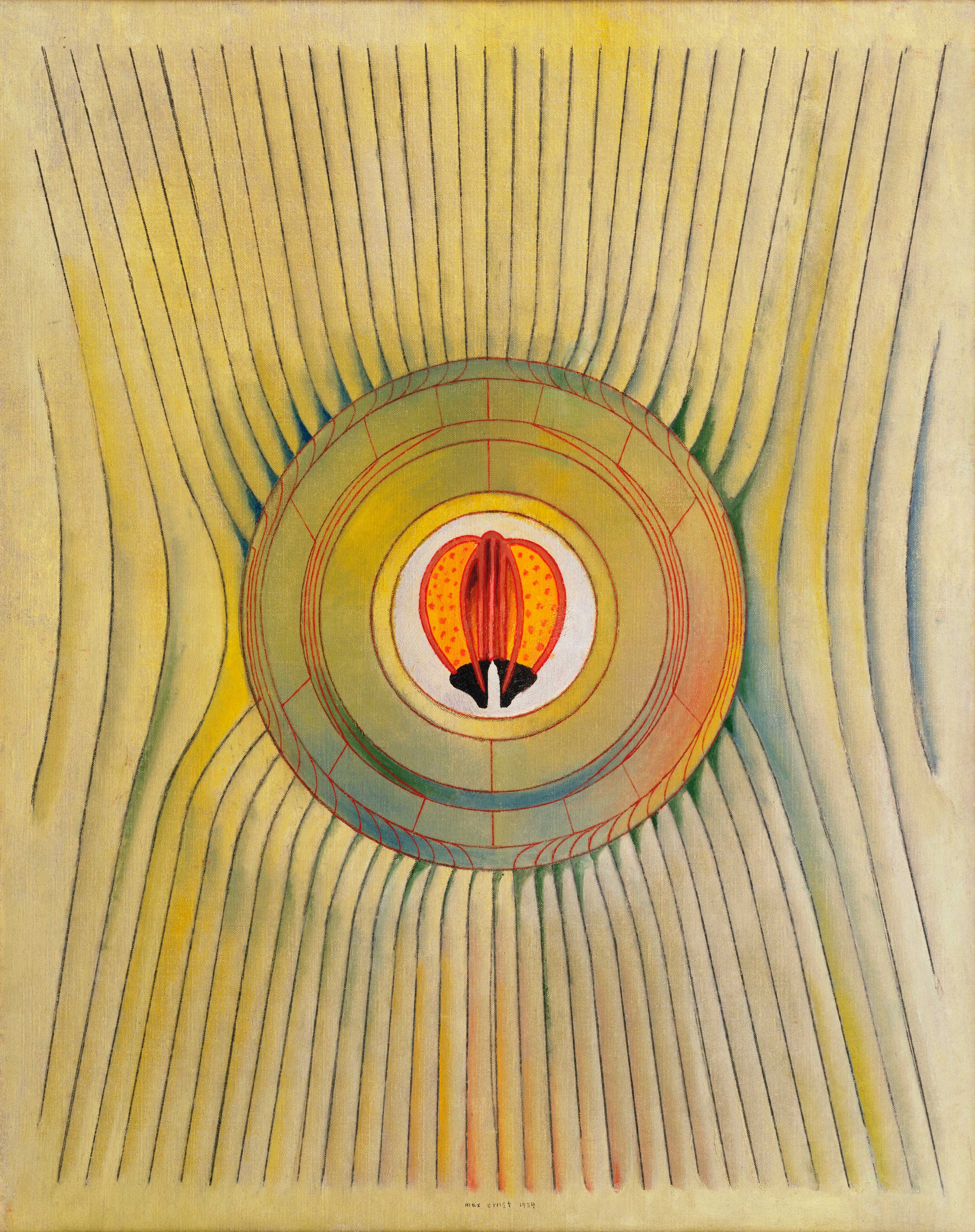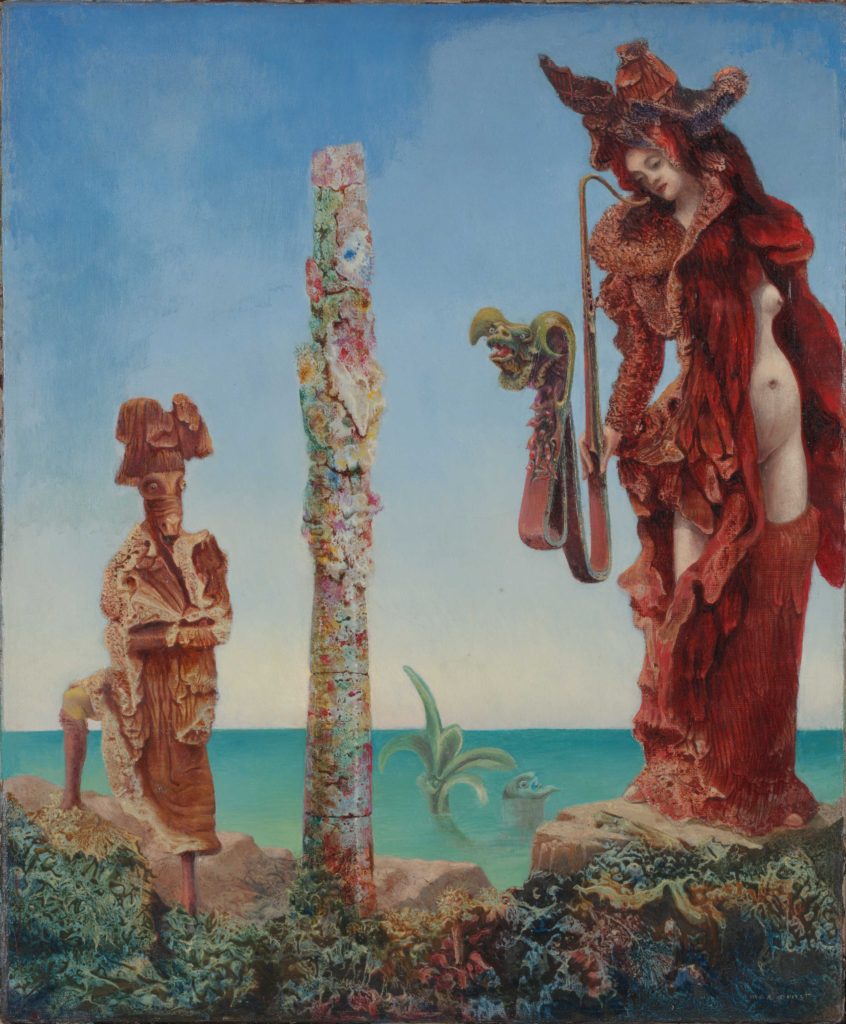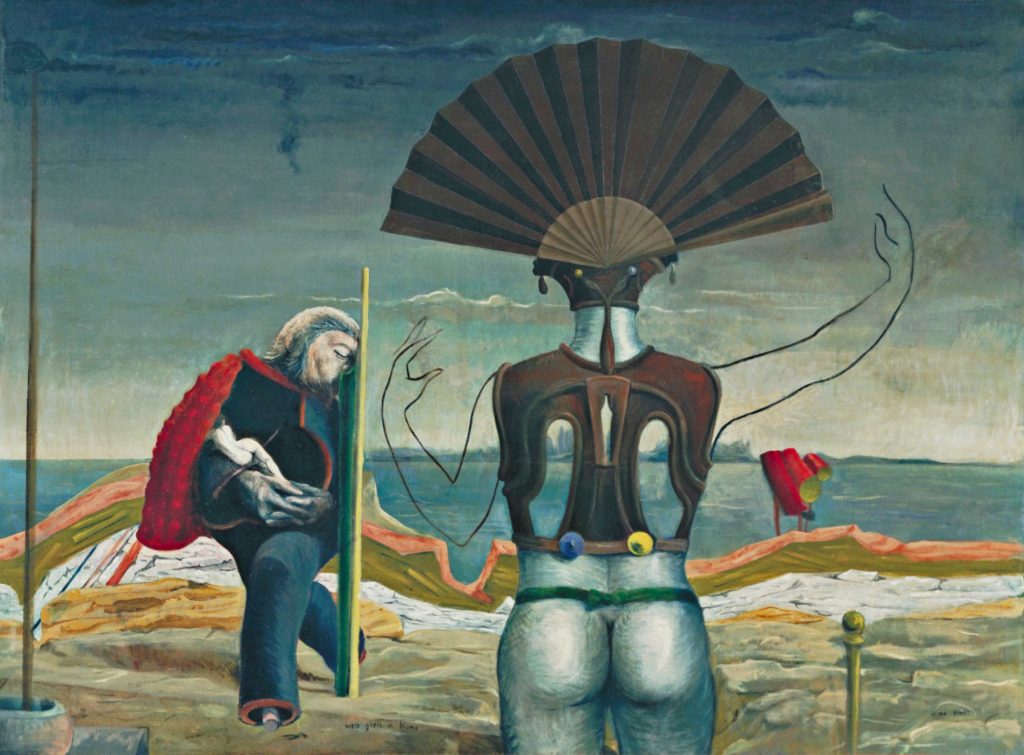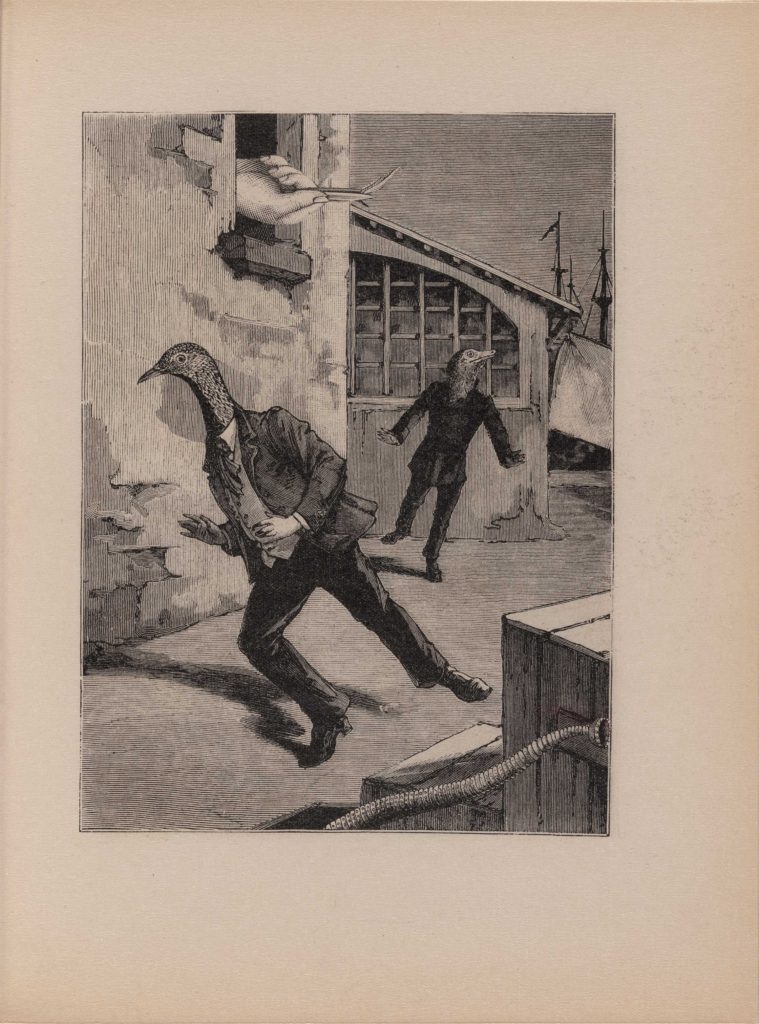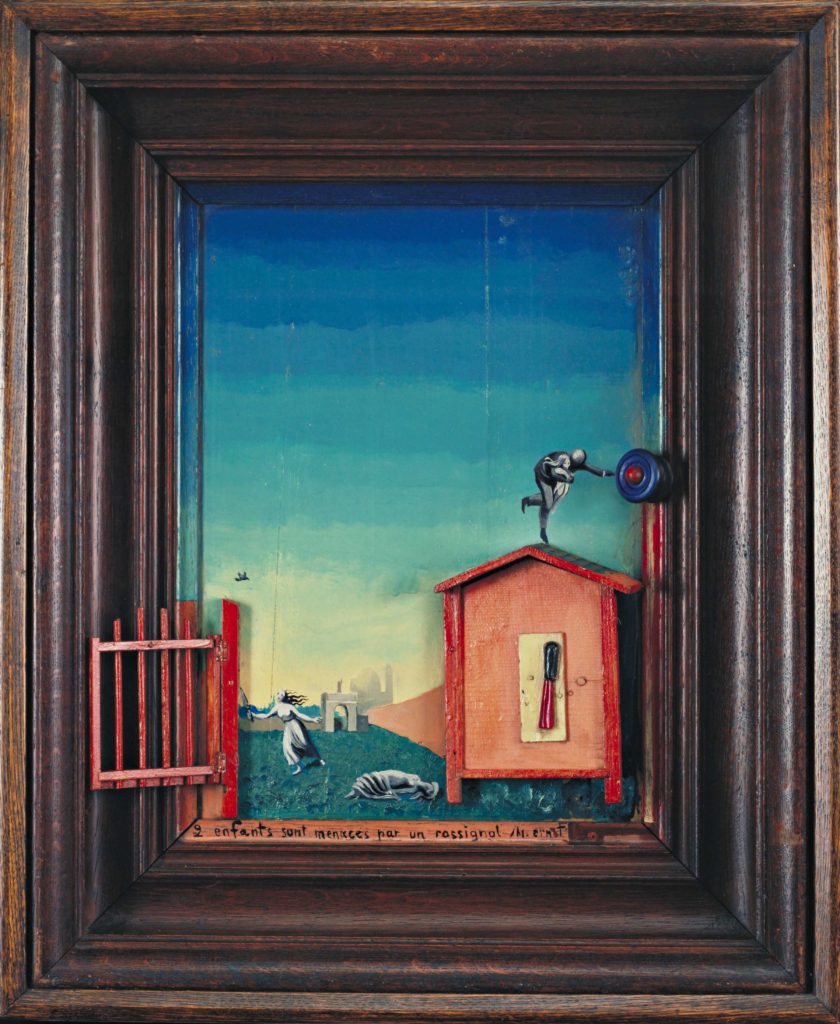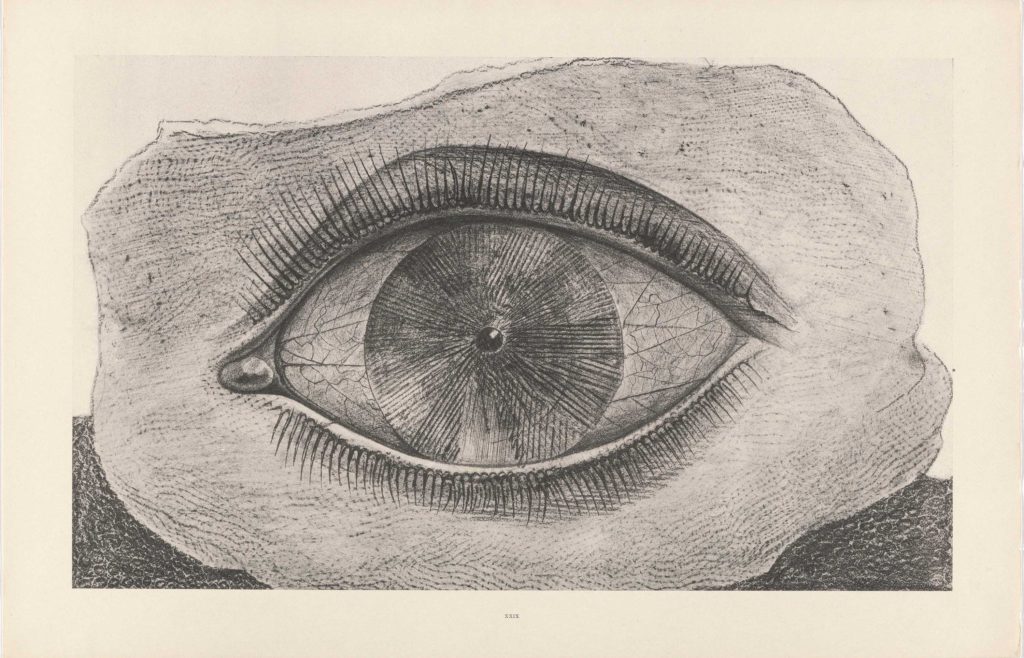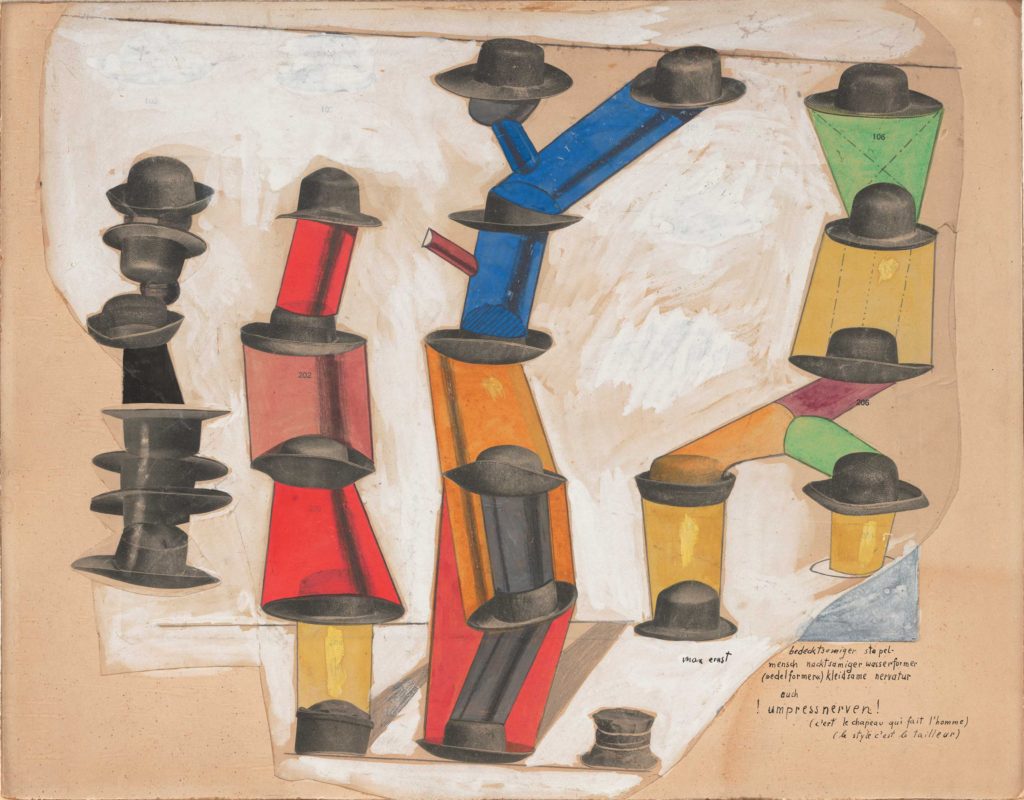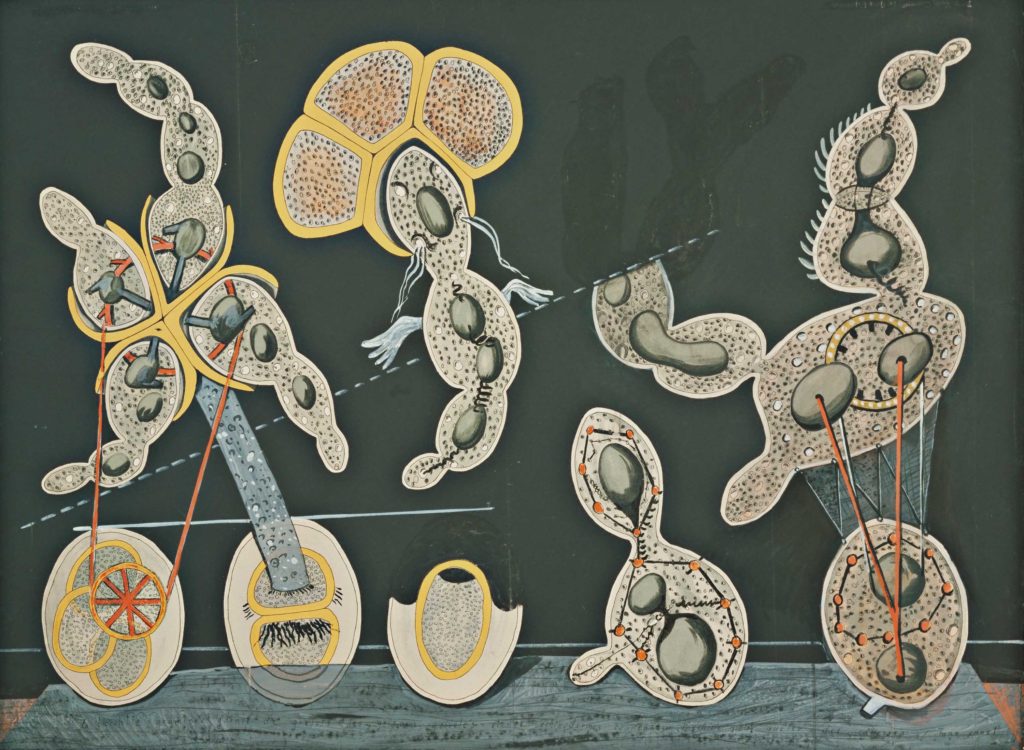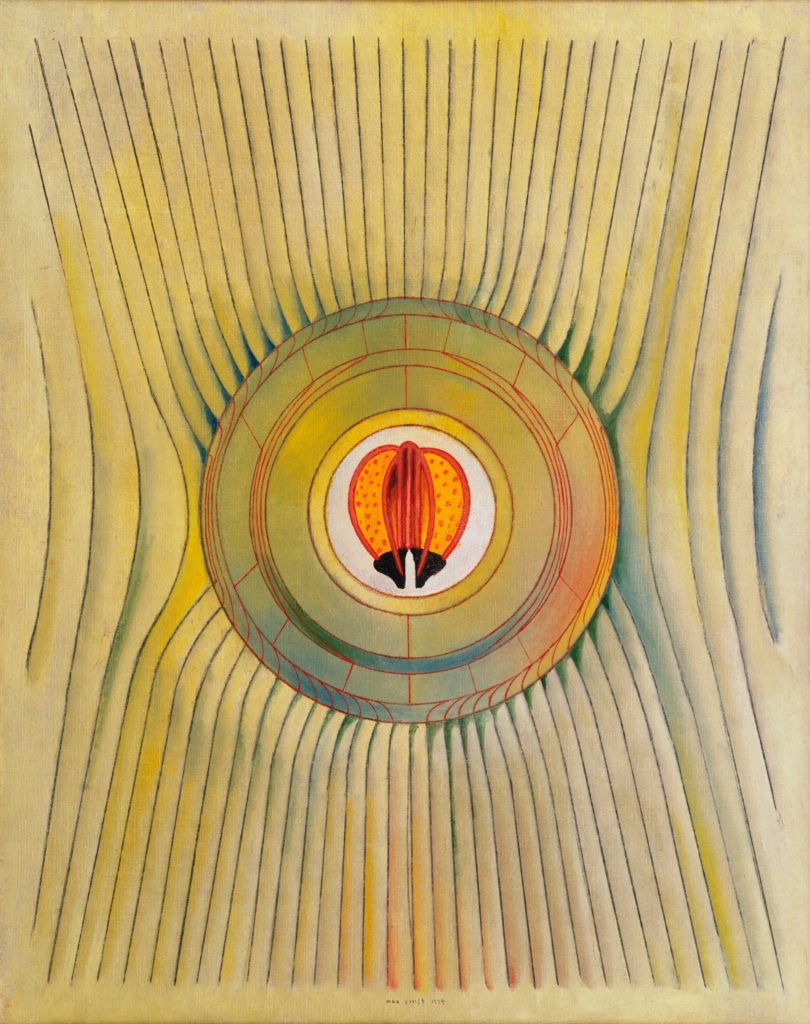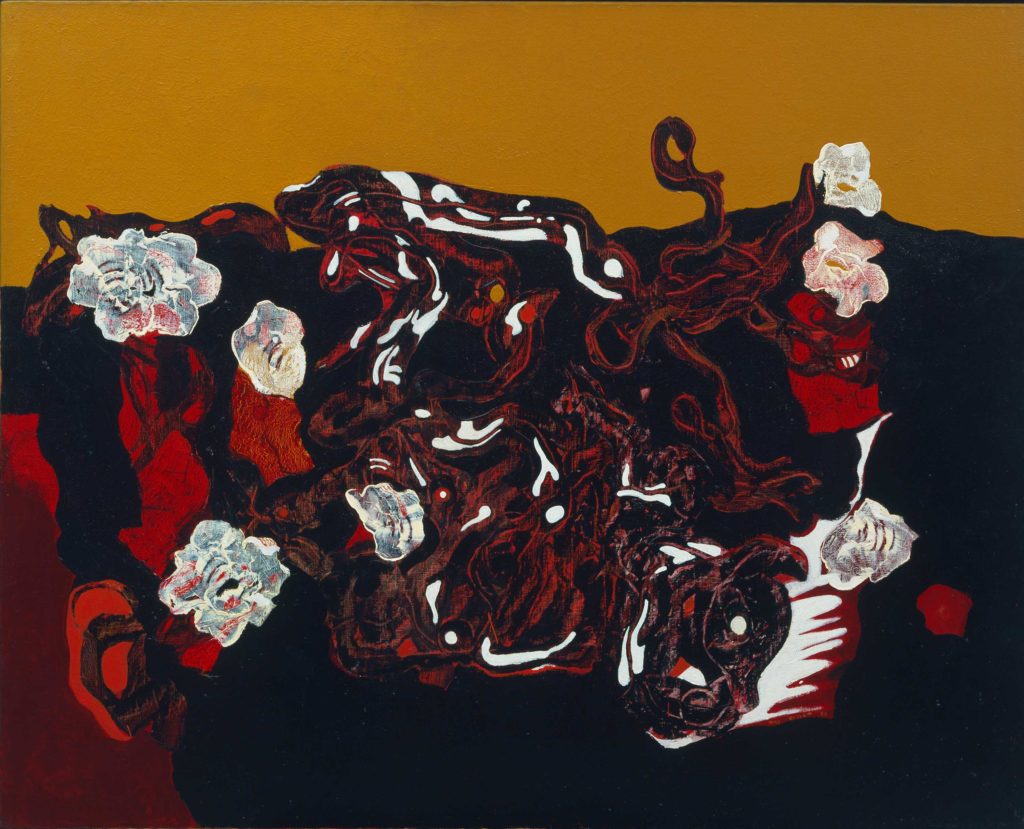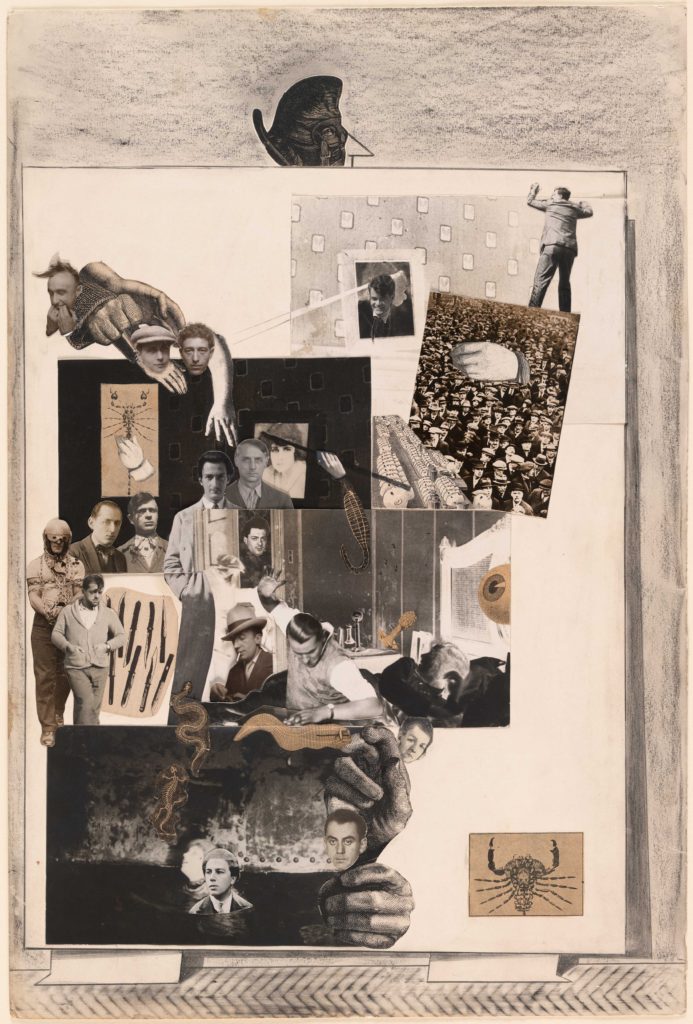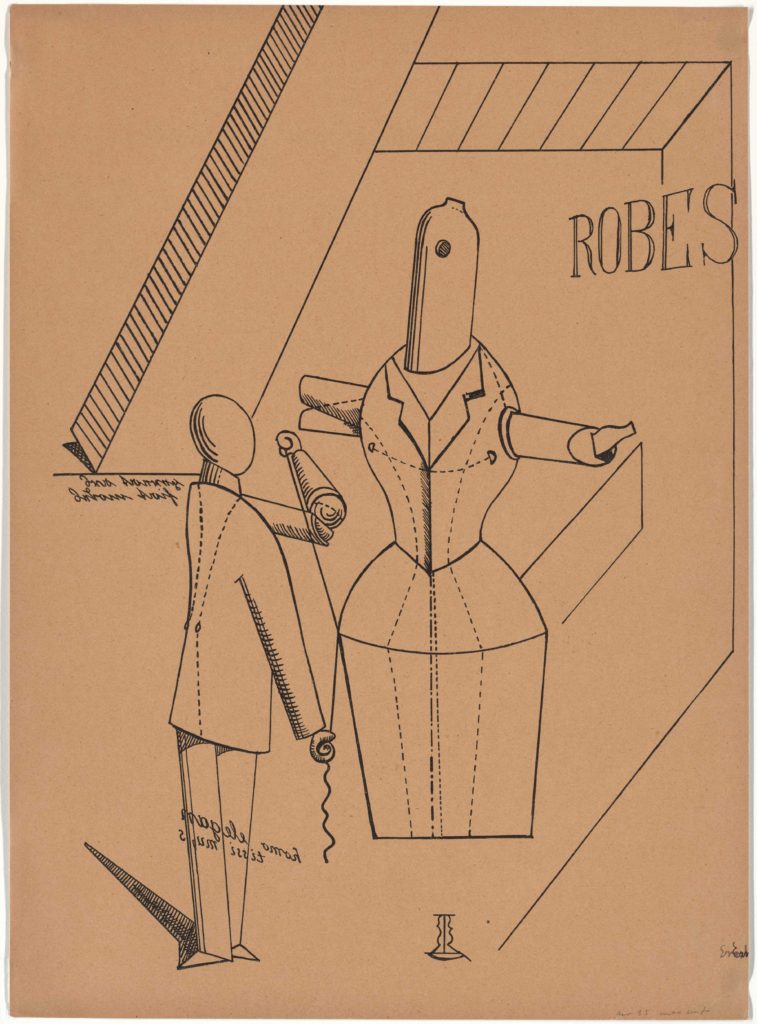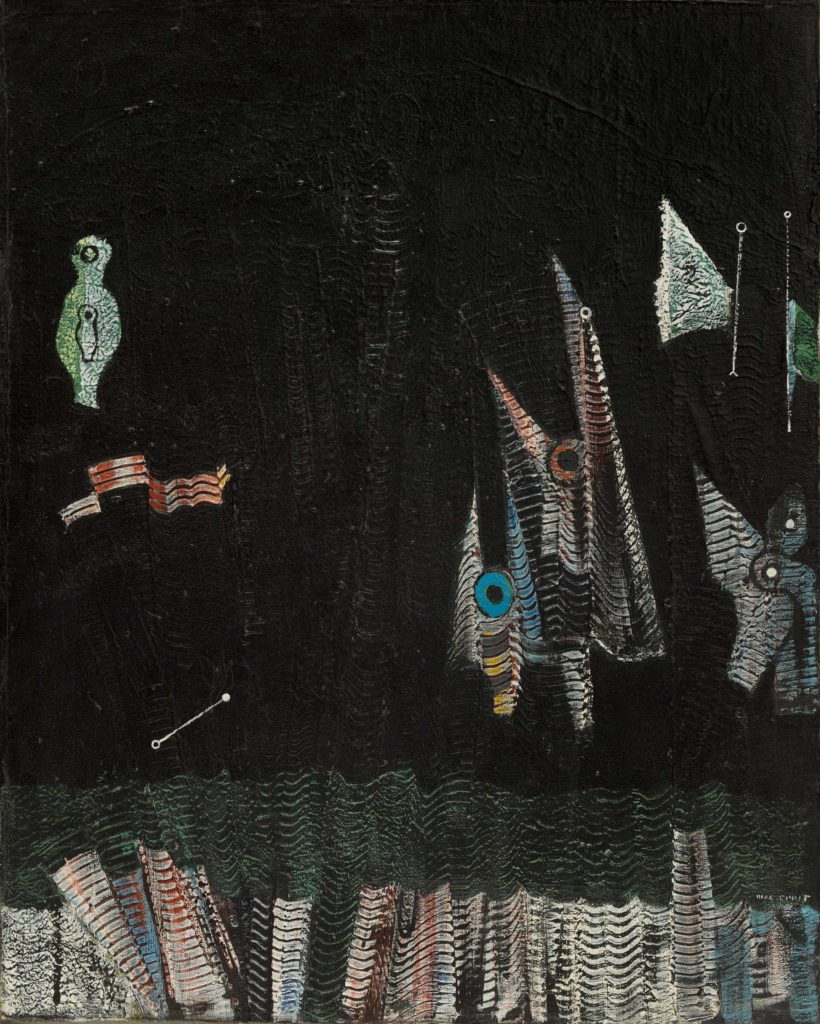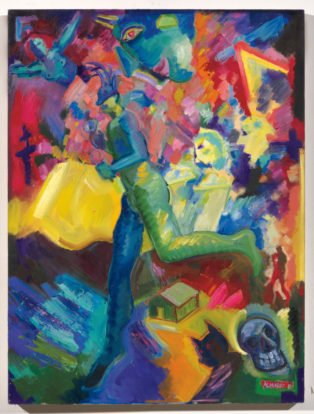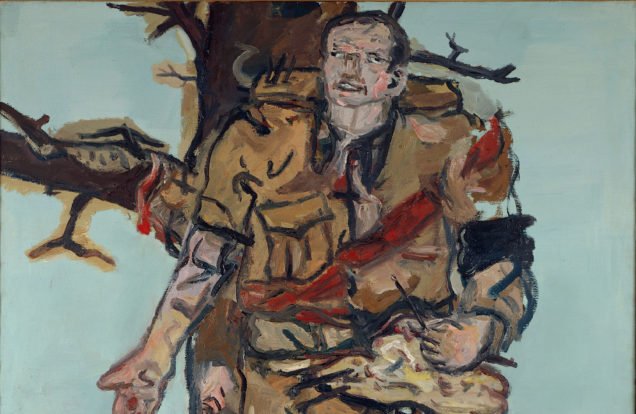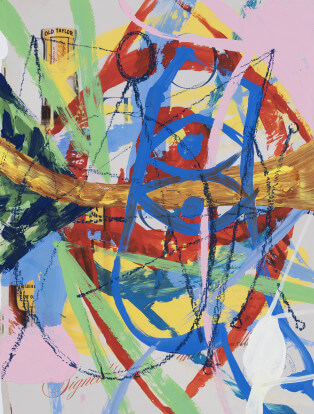BY: Jes Zurell
Iconic Surrealist artist Max Ernst was French and American by blood, and born in Germany in 1891. If we were to translate that into erotic clichés, one might estimate him to be a well-read romantic with a hero complex and a deep appreciation for rock-hard engineering – the kind of lay that recites poetry in your ear while he sexes you through a standardized sequence of positions, then climaxes with a belligerent “You’re welcome, little lady.”
In reality, Ernst may or may not have been far from those stereotypes, but his prolific status in the art world roots itself in his role as a founder of Surrealism and the Dada movement. In Max Ernst: Beyond Painting Museum of Modern Art in New York City, we see the doggedly experimental work he produced during and in in the wake of the first World War.
The pieces range from thin-yet-saturated works in dry media, depicting shapes that are neither here nor there, to a slick painting of an Amazon-like Wonder Woman type who cheekily flashes her derriere toward the audience. The enveloping feeling of the art is that rules are made to be broken, and we couldn’t agree more.
PROVOKR warmly invites you to give your mind a good rub-down with Ernst’s work. Better yet, go spend some time with it at MoMA one-on-one before the show closes on New Year’s Day 2018.
Max Ernst. Napoleon in the Wilderness. 1941. Oil on canvas. 18 1/4 x 15″ (46.3 x 38.1 cm). The Museum of Modern Art, New York. Purchase and exchange, 1942. Photo: Thomas Griesel. © 2017 Artists Rights Society (ARS), New York / ADAGP, Paris.
Max Ernst. Woman, Old Man, and Flower (Weib, Greis und Blume). Paris 1923, Eaubonne 1924. Oil on canvas. 38 x 51 1/4″ (96.5 x 130.2 cm). The Museum of Modern Art, New York. Purchase, 1937. Photo: Kate Keller. © 2017 Artists Rights Society (ARS), New York / ADAGP, Paris.
Max Ernst. One page from Oedipus (Oedipe), Volume IV, from A Week of Kindness or the Seven Capital Elements (Une Semaine de bonté ou les sept éléments capitaux). 1933–34, published 1934. Line block after collage, from a five-volume serial novel with 182 line blocks after collages. Page: 10 3/4 x 8 1/16″ (27 x 20.5 cm). Publisher: Éditions Jeanne Bucher, Paris. Printer: Georges Duval, Paris. Edition: 812. The Museum of Modern Art, New York. The Louis E. Stern Collection, 1964. Photo: Robert Gerhardt. © 2017 Artists Rights Society (ARS), New York / ADAGP, Paris.
Max Ernst. Two Children Are Threatened by a Nightingale (Deux enfants sont menáces par un rossignol). 1924. Oil on wood with painted wood elements and frame. 27 1/2 x 22 1/2 x 4 1/2″ (69.8 x 57.1 x 11.4 cm). The Museum of Modern Art, New York. Purchase,1937. Photo: Kate Keller. © 2017 Artists Rights Society (ARS), New York / ADAGP, Paris.
Max Ernst. The Wheel of Light (La Roue de la lumière) from Natural History (Histoire naturelle). c. 1925, published 1926. One from a portfolio of 34 collotypes after frottage. Sheet: 12 11/16 × 19 5/8″ (32.3 × 49.8 cm). Publisher: Galerie Jeanne Bucher, Paris. Printer: unknown. Edition: 300. The Museum of Modern Art, New York. Gift of James Thrall Soby, 1959. Photo: Peter Butler. © 2017 Artists Rights Society (ARS), New York / ADAGP, Paris.
Max Ernst. The Hat Makes the Man (C’est le chapeau qui fait l’homme). 1920. Gouache, pencil, oil, and ink on cut‑and‑pasted printed paper on paper. 13 7/8 x 17 3/4″ (35.2 x 45.1 cm). The Museum of Modern Art, New York. Purchase, 1935. Photo: Paige Knight. © 2017 Artists Rights Society (ARS), New York / ADAGP, Paris.
Max Ernst. The Gramineous Bicycle Garnished with Bells the Dappled Fire Damps and the Echinoderms Bending the Spine to Look for Caresses (La Biciclette graminée garnie de grelots les grisons grivelés et les échinodermes courbants l’échine pour quêter des caresses). c. 1921. Gouache, ink, and pencil on printed paper on paperboard. 29 1/4 x 39 1/4″ (74.3 x 99.7 cm). The Museum of Modern Art, New York. Purchase, 1937. Photo: Robert Gerhardt. © 2017 Artists Rights Society (ARS), New York / ADAGP, Paris.
Max Ernst. The Blind Swimmer (Nageur aveugle). 1934. Oil on canvas. 36 3/8 x 29″ (92.3 x 73.5 cm). The Museum of Modern Art, New York. Gift of Mrs. Pierre Matisse and the Helena Rubenstein Fund,1968. Photo: Mali Olatunji. © 2017 Artists Rights Society (ARS), New York / ADAGP, Paris.
Max Ernst. Rendezvous of Friends ‑ The Friends Become Flowers (Le rendez-vous des amis – Les amis se changent en fleurs). 1928. Oil on canvas. 51 1/8 x 63 3/4″ (129.8 x 161.9 cm). The Museum of Modern Art, New York. Gift of Samuel A. Berger and the artist (by exchange), 1973. Photo: Paige Knight. © 2017 Artists Rights Society (ARS), New York / ADAGP, Paris.
Max Ernst. Loplop Introduces Members of the Surrealist Group (Loplop présente les membres du groupe surréaliste). 1931. Cut‑and‑pasted gelatin silver prints, cut‑and‑pasted printed paper, pencil, and pencil frottage on paper. 19 3/4 x 13 1/4″ (50.1 x 33.6 cm). The Museum of Modern Art, New York. Purchase, 1935. Photo: John Wronn. © 2017 Artists Rights Society (ARS), New York / ADAGP, Paris.
Max Ernst. Plate I from Let There Be Fashion, Down with Art (Fiat modes pereat ars). c. 1919. One from a portfolio of eight lithographs. Sheet: 17 3/16 x 12 9/16″ (43 x 31.9 cm). Publisher: Schlömilch Verlag, Cologne. Printer: unknown, Cologne. Edition: 60 announced; only a few known sets. The Museum of Modern Art, New York. Purchase, 1935. Photo: John Wronn. © 2017 Artists Rights Society (ARS), New York / ADAGP, Paris.
Max Ernst. Birds above the Forest (Oiseaux au-dessus de la forêt). 1929. Oil on canvas. 31 3/4 x 25 1/4″ (80.6 x 64.1 cm). The Museum of Modern Art, New York. Katherine S. Dreier Bequest, 1953. Photo: John Wronn. © 2017 Artists Rights Society (ARS), New York / ADAGP, Paris.

